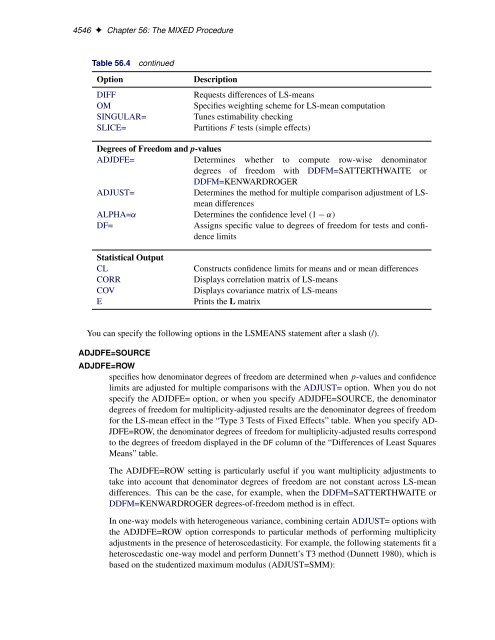SAS/STAT 922 User's Guide: The MIXED Procedure (Book Excerpt)
SAS/STAT 922 User's Guide: The MIXED Procedure (Book Excerpt)
SAS/STAT 922 User's Guide: The MIXED Procedure (Book Excerpt)
Create successful ePaper yourself
Turn your PDF publications into a flip-book with our unique Google optimized e-Paper software.
4546 ✦ Chapter 56: <strong>The</strong> <strong>MIXED</strong> <strong>Procedure</strong><br />
Table 56.4 continued<br />
Option Description<br />
DIFF Requests differences of LS-means<br />
OM Specifies weighting scheme for LS-mean computation<br />
SINGULAR= Tunes estimability checking<br />
SLICE= Partitions F tests (simple effects)<br />
Degrees of Freedom and p-values<br />
ADJDFE= Determines whether to compute row-wise denominator<br />
degrees of freedom with DDFM=SATTERTHWAITE or<br />
DDFM=KENWARDROGER<br />
ADJUST= Determines the method for multiple comparison adjustment of LSmean<br />
differences<br />
ALPHA=˛ Determines the confidence level (1 ˛)<br />
DF= Assigns specific value to degrees of freedom for tests and confidence<br />
limits<br />
Statistical Output<br />
CL Constructs confidence limits for means and or mean differences<br />
CORR Displays correlation matrix of LS-means<br />
COV Displays covariance matrix of LS-means<br />
E Prints the L matrix<br />
You can specify the following options in the LSMEANS statement after a slash (/).<br />
ADJDFE=SOURCE<br />
ADJDFE=ROW<br />
specifies how denominator degrees of freedom are determined when p-values and confidence<br />
limits are adjusted for multiple comparisons with the ADJUST= option. When you do not<br />
specify the ADJDFE= option, or when you specify ADJDFE=SOURCE, the denominator<br />
degrees of freedom for multiplicity-adjusted results are the denominator degrees of freedom<br />
for the LS-mean effect in the “Type 3 Tests of Fixed Effects” table. When you specify AD-<br />
JDFE=ROW, the denominator degrees of freedom for multiplicity-adjusted results correspond<br />
to the degrees of freedom displayed in the DF column of the “Differences of Least Squares<br />
Means” table.<br />
<strong>The</strong> ADJDFE=ROW setting is particularly useful if you want multiplicity adjustments to<br />
take into account that denominator degrees of freedom are not constant across LS-mean<br />
differences. This can be the case, for example, when the DDFM=SATTERTHWAITE or<br />
DDFM=KENWARDROGER degrees-of-freedom method is in effect.<br />
In one-way models with heterogeneous variance, combining certain ADJUST= options with<br />
the ADJDFE=ROW option corresponds to particular methods of performing multiplicity<br />
adjustments in the presence of heteroscedasticity. For example, the following statements fit a<br />
heteroscedastic one-way model and perform Dunnett’s T3 method (Dunnett 1980), which is<br />
based on the studentized maximum modulus (ADJUST=SMM):

















